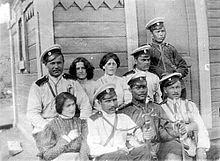Akatuy katorga

Akatuy penal camp in 1911 and was finally shut down after the February Revolution of 1917.
George Kennan visited the remnants of the mine in 1885. He noted:
"Lunin, one of the Decembrist conspirators of 1825, lived and died in penal servitude at this mine, and somewhere in the neighborhood lie buried many of the Polish patriots sent to Akatui after the insurrection of 1863. The Russian Government does not take pains to perpetuate the memory of the political offenders whom it tortures to death in its Siberian prisons, and over moldering bodies of most of them there is not so much as a mound. If there is in Siberia a more lonely, a more cheerless, a more God-forsaken place than Kara, it is the snowy, secluded valley of Akatui."[1]
Notable inmates

- Yekaterina Bibergal
- Vasily Chashchin
- Grigory Gershuni
- Mikhail Gots
- Pyotr Karpovich, who assassinated Minister of National Enlightenment Nikolay Bogolepov
- Fanny Kaplan
- Pyotr Kulikovsky
- Viktor Kurnatovsky
- Alexey Kuznetsov (revolutionary)
- Michael Lunin
- Lev Mirsky
- Pavel Moshkin
- Ivan Okuntsov
- Prosh Proshian
- "The six" (the shesterka), a group of prominent female Socialist Revolutionary terrorists[2]
- Mikhail Svidzinsky
- Vladimir Vilensky-Sibiryakov
- Pyotr Yakubovich
- Ivan Yudin
- Aaron Zundelevich
